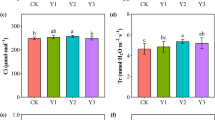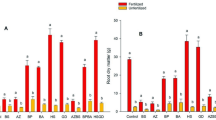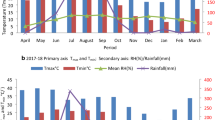Abstract
Bacterial species in the plant-beneficial-environmental branch of Alcaligenes characterize an important part of rhizosphere microbes. The effects of plant growth-promoting Alcaligenes sp. AZ9 (accession #KU494828) on soil status and maize (Zea mays L.) performance were evaluated in single or combined applications with soil amendments, such as biochar (BC) prepared through pyrolysis of maize straw at 300 ºC, rock phosphate enriched compost (CM), and humic acid (HA) in two wirehouse experiments under natural environment. Qualitative P solubilization of Alcaligenes sp. AZ9 revealed the appearance of a halo zone up to 19.1 mm in agar medium with P solubilizing index 4.27 and P solubilizing efficiency 327%. Alcaligenes sp. AZ9 showed solubilization of P up to 30.85 µg mL−1 by lowering pH of medium from 7.0 to 5.25. The application of Alcaligenes sp. AZ9 significantly improved soil biological attributes, such as bacterial colony forming unit by 20.5%, soil organic carbon by 10.3%, soil organic matter by 5.1%, and water content of saturated soil by 5.7%. The combined application of Alcaligenes sp. AZ9 with either BC, CM, or HA or with their mixture (BC plus CM plus HA) significantly increased the above biological attributes of soil than the application of Alcaligenes sp. AZ9 alone. Moreover, the integrated application of Alcaligenes sp. AZ9 with BC, CM, and HA significantly improved growth and yield attributes of maize in terms of root length (26%), plant height (39%), shoot fresh biomass (31%), shoot dry biomass (32%), root fresh biomass (30%), root dry biomass (34%), 100-grains weight (26%), stover yield (28%), and grain yield (19%). Similarly, the integrated application of Alcaligenes sp. AZ9 with BC, CM, and HA promoted N, P, and K in maize grain concentration by 12%, 11%, and 11%, respectively, compared with the application of organic amendments without Alcaligenes sp. AZ9. Combined application of Alcaligenes sp. AZ9 with BC, CM, and HA could be an effective strategy to improve plant growth, nutrients uptake, and yield of maize in the context of sustainable agriculture. In future research, the effects of integrated application of Alcaligenes sp. AZ9 with BC, CM, and/or HA should be further evaluated under field conditions.






Similar content being viewed by others
References
Ahmad F, Ahmad I, Khan MS (2008) Screening of free-living rhizospheric bacteria for their multiple plant growth promoting activities. Microbiol Res 163:173–181
Ahmad M, Zahir ZA, Khalid M (2013) Efficacy of Rhizobium and Pseudomonas strains to improve physiology, ionic balance and quality of mung bean under salt-affected conditions on farmer’s fields. Plant Physiol Biochem 63:170–176
Ahmad M, Adil Z, Hussain A, Mumtaz MZ, Nafees M, Ahmad I, Jamil M (2019) Potential of phosphate solubilizing Bacillus strains for improving growth and nutrient uptake in mungbean and maize crops. Pakistan J Agric Sci 56:283–289
Alexander M (1982) Most probable number method for microbial populations. In: Page AL, Miller RH, Keeney DR (eds) Methods of soil analysis, part 2. ASA and SSA, Madison, WI, pp 815–820
Ali S, Rizwan M, Qayyum MF, Ok YS, Ibrahim M, Riaz M, Arif MS, Hafeez F, Al-Wabel MI, Shahzad AN (2017) Biochar soil amendment on alleviation of drought and salt stress in plants: a critical review. Environ Sci Pollut Res 24:12700–12712
Aloni R, Aloni E, Langhans M (2006) Role of cytokinin and auxin in shaping root architecture: regulating vascular differentiation, lateral root initiation, root apical dominance and root gravitropism. Ann Bot 97:883–893
Bal HB, Nayak L, Das S, Adhya TK (2013) Isolation of ACC deaminase producing PGPR from rice rhizosphere and evaluating their plant growth promoting activity under salt stress. Plant Soil 366:93–105
Batista EMCC, Shultz J, Matos TTS, Fornari MR, Ferreira TM (2018) Effect of surface and porosity of biochar on water holding capacity aiming indirectly at preservation of the Amazon biome. Sci Rep 8:10677
Belimov AA, Safronova VI, Sergeyeva TA, Egorova TN, Matveyeva VA (2001) Characterization of plant growth promoting rhizobacteria isolated from polluted soils and containing 1-aminocyclopropane-1-carboxylate deaminase. Can J Microbiol 47:642–652
Bertrand M, Barot S, Blouin M, Whalen J, De Oliveira T (2015) Earthworm services for cropping systems. A review. Agron Sustain Dev 35:553–567
Bouyoucos GJ (2006) The hydrometer as a new method for the mechanical analysis of soils. Soil Sci 54:464–465
Bric JM, Bostock RM, Silverstone SE (1991) Rapid in situ assay for indoleacetic acid production by bacteria immobilized on a nitrocellulose membrane. Appl Environ Microbiol 57:535–538
Chakraborty A, Chakrabarti K, Chakraborty A, Ghosh S (2011) Effect of long-term fertilizers and manure application on microbial biomass and microbial activity of a tropical agricultural soil. Biol Fertil Soils 47:227–233
Chapman HD, Pratt PF (1961) Methods of analysis for soils, plants and waters. University of California, Berkeley, CA
Chèneby D, Iuretig G, Hallet S, Germon JC, Philippot L (2004) Denitrifying bacteria in bulk and maize-rhizospheric soil: diversity and N2O-reducing abilities. Can J Microbiol 50:469–474
Chesworth W (2008) Encyclopedia of soil science. Springer, Dordrecht
Cotrufo MF, Wallenstein MD, Boot CM, Denef K, Paul E (2013) The microbial efficiency-matrix stabilization (MEMS) framework integrates plant litter decomposition with soil organic matter stabilization: do labile plant inputs form stable soil organic matter? Glob Change Biol 19:988–995
Cotrufo MF, Soong JL, Horton AJ, Campbell EE, Haddix ML, Wall DH, Parton WJ (2015) Formation of soil organic matter via biochemical and physical pathways of litter mass loss. Nat Geosci 8:776–779
Ditta A, Arshad M, Zahir ZA, Jamil A (2015) Comparative efficacy of rock phosphate enriched organic fertilizer vs. mineral phosphatic fertilizer for nodulation, growth and yield of lentil. Int J Agric Biol 17:589–595
El-Akhal MR, Rincon A, Coba de la Peña T, Lucas MM, El Mourabit N, Barrijal S, Pueyo JJ (2013) Effects of salt stress and rhizobial inoculation on growth and nitrogen fixation of three peanut cultivars. Plant Biol 15:415–421
Fasim F, Ahmed N, Parsons R, Gadd GM (2002) Solubilization of zinc salts by a bacterium isolated from the air environment of a tannery. FEMS Microbiol Lett 213:1–6
Glick BR, Cheng Z, Czarny J, Duan J (2007) Promotion of plant growth by ACC deaminase-producing soil bacteria. Eur J Plant Pathol 119:329–339
Gouda S, Kerry RG, Das G, Paramithiotis S, Shin HS, Patra JK (2018) Revitalization of plant growth promoting rhizobacteria for sustainable development in agriculture. Microbiol Res 206:131–140
Govindarajan M, Balandreau J, Kwon SW (2007) Effects of the inoculation of Burkholderia vietnamensis and related endophytic diazotrophic bacteria on grain yield of rice. Microb Ecol 55:21–37
Hale L, Luth M, Kenney R, Crowley D (2014) Evaluation of pinewood biochar as a carrier of bacterial strain Enterobacter cloacae UW5 for soil inoculation. Appl Soil Ecol 84:192–199
Hale L, Luth M, Crowley D (2015) Biochar characteristics relate to its utility as an alternative soil inoculum carrier to peat and vermiculite. Soil Biol Biochem 81:228–235
Han G, Lan J, Chen Q, Yu C, Bie S (2017) Response of soil microbial community to application of biochar in cotton soils with different continuous cropping years. Sci Rep 7:1–11
Honma M, Smmomura T (1978) Metabolism of 1-aminocyclopropane-1-carboxylic acid. Agric Biol Chem 42:1825–1831
Hussain A, Arshad M, Zahir ZA, Asghar M (2015) Prospects of zinc solubilizing bacteria for enhancing growth of maize. Pakistan J Agric Sci 52:915–922
Hussain A, Ahmad M, Mumtaz MZ, Nazli F, Farooqi MA, Khalid I, Iqbal Z, Arshad H (2019) Impact of integrated use of enriched compost, biochar, humic acid and Alcaligenes sp. AZ9 on maize productivity and soil biological attributes in natural field conditions. Italian J Agron 14:101–107
Jackson ML (1973) Soil chemical analysis. Prentice Hall Pvt, Ltd, New Delhi, India
Jaremko D, Kalembasa D (2014) A comparison of methods for the determination of cation exchange capacity of soils. Ecol Chem Eng S 21:487–498
Jeffery S, Meinders MB, Stoof CR, Bezemer TM, Van de Voorde TF, Mommer L, Van Groenigen JW (2015) Biochar application does not improve the soil hydrological function of a sandy soil. Geoderma 251:47–54
Jenkinson DS (1981) Microbial biomass in soil: measurement and turnover. Soil Biochem 5:415–471
Jian S, Li J, Chen J, Wang G, Mayes MA, Dzantor KE, Hui D, Luo Y (2016) Soil extracellular enzyme activities, soil carbon and nitrogen storage under nitrogen fertilization: a meta-analysis. Soil Biol Biochem 101:32–43
Juan LI, Li YT, Yang XD, Zhang JJ, Lin ZA, Zhao BQ (2015) Microbial community structure and functional metabolic diversity are associated with organic carbon availability in an agricultural soil. J Integr Agric 14:2500–2511
Kakar KU, Nawaz Z, Cui Z, Almoneafy AA, Ullah R, Shu Q-Y (2018) Rhizosphere-associated Alcaligenes and Bacillus strains that induce resistance against blast and sheath blight diseases, enhance plant growth and improve mineral content in rice. J Appl Microbiol 124:779–796
Kallenbach CM, Frey SD, Grandy AS (2016) Direct evidence for microbial-derived soil organic matter formation and its ecophysiological controls. Nat Commun 7:13630
Koivunen EE, Tully KL, Swett CL (2018) Co-managing soil and plant pathogens: effects of organic amendments on soil fertility and fungal pathogen survival. Plant Soil 432:171–189
Kumar A, Patel JS, Meena VS, Ramteke PW (2019) Plant growth-promoting rhizobacteria: strategies to improve abiotic stresses under sustainable agriculture. J Plant Nutr 42:1402–1415
Lehmann J, Kleber M (2015) The contentious nature of soil organic matter. Nature 528:1–9
Li Z, Schneider RL, Morreale SJ, Xie Y, Li C, Li J (2018) Woody organic amendments for retaining soil water, improving soil properties and enhancing plant growth in desertified soils of Ningxia, China. Geoderma 310:143–152
Lin Y, Watts DB, Kloepper JW, Torbert HA (2018) Influence of plant growth-promoting rhizobacteria on corn growth under different fertility sources. Commun Soil Sci Plant Anal 49:1239–1255
Louden BC, Haarmann D, Lynne AM (2011) Use of blue agar CAS assay for siderophore detection. J Microbiol Biol Educ 12:51–53
McGill WB, Figueiredo CT (1993) Total nitrogen: chapter 22. In: Carter MR (Ed) Soil sampling and methods of analysis. Lewis Publishers, Boca Raton, FL.
Moharana PC, Meena MD, Biswas DR (2018) Role of phosphate-solubilizing microbes in the enhancement of fertilizer value of rock phosphate through composting technology. In: Meena VS (Ed) Role of rhizospheric microbes in soil: nutrient management and crop improvement. Springer Nature Singapore Pte Ltd, Singapore.
Montiel-Rozas MM, Domínguez MT, Madejón E, Madejón P, Pastorelli R, Renella G (2018) Long-term effects of organic amendments on bacterial and fungal communities in a degraded Mediterranean soil. Geoderma 332:20–28
Mumtaz MZ, Ahmad M, Jamil M, Hussain T (2017) Zinc solubilizing Bacillus spp. potential candidates for biofortification in maize. Microbiol Res 202:51–60
Mumtaz MZ, Ahmad M, Jamil M, Asad SA, Hafeez F (2018) Bacillus strains as potential alternate for zinc biofortification of maize grains. Int J Agric Biol 20:1779–1786
Munoz-Rojas J, Caballero-Mellado J (2003) Population dynamics of Gluconacetobacter diazotrophicus in sugarcane cultivars and its effect on plant growth. Microb Ecol 46:454–464
Mus F, Crook MB, Garcia K, Costas AG, Geddes BA, Kouri ED, Paramasivan P, Ryu MH, Oldroyd GE, Poole PS, Udvardi MK (2016) Symbiotic nitrogen fixation and the challenges to its extension to nonlegumes. Appl Environ Microbiol 82:3698–3710
Nadeem SM, Imran M, Naveed M, Khan MY, Ahmad M, Zahir ZA, Crowley DE (2017) Synergistic use of biochar, compost and plant growth promoting rhizobacteria for enhancing cucumber growth under water deficit conditions. J Sci Food Agric 97:5139–5145
Naeem MA, Khalid M, Ahmad Z, Naveed M (2016) Low pyrolysis temperature biochar improves growth and nutrient availability of maize on typic Calciargid. Commun Soil Sci Plant Anal 47:41–51
Nie S, Zhao L, Lei X, Sarfraz R, Xing S (2018) Dissolved organic nitrogen distribution in differently fertilized paddy soil profiles: implications for its potential loss. Agric Ecosyst Environ 262:58–64
Noorhosseini SA, Damalas CA (2018) Environmental impact of peanut (Arachis hypogaea L) production under different levels of nitrogen fertilization. Agriculture 8:104
Oldfield EE, Bradford MA, Wood SA (2019) Global meta-analysis of the relationship between soil organic matter and crop yields. Soil 5:15–32
Peltre C, Gregorich EG, Bruun S, Jensen LS, Magid J (2017) Repeated application of organic waste affects soil organic matter composition: evidence from thermal analysis, FTIR-PAS, amino sugars and lignin biomarkers. Soil Biol Biochem 104:117–127
Penrose DM, Glick BR (2003) Methods for isolating and characterizing ACC deaminase-containing plant growth-promoting rhizobacteria. Physiol Plant 118:10–15
Perrière G, Gouy M (1996) WWW-Query: an on-line retrieval system for biological sequence banks. Biochimie 78:364–369
Pii Y, Mimmo T, Tomasi N, Terzano R, Cesco S, Crecchio C (2015) Microbial interactions in the rhizosphere: beneficial influences of plant growth-promoting rhizobacteria on nutrient acquisition process. A review. Biol Fert Soils 51:403–415
Pikovskaya RI (1948) Mobilization of phosphates in soil in connection with vital activity of some microbial species. Microbiologia 17:362–370
Rasmussen C, Heckman K, Wieder WR, Keiluweit M, Lawrence CR, Berhe AA, Blankinship JC, Crow SE, Druhan JL, Pries CEH, Marin-Spiotta E (2018) Beyond clay: towards an improved set of variables for predicting soil organic matter content. Biogeochem 137:297–306
Rubin RL, Van Groenigen KJ, Hungate BA (2017) Plant growth promoting rhizobacteria are more effective under drought: a meta-analysis. Plant Soil 416:309–323
Ryan J, Estefan G, Rashid A (2001) Soil and plant analysis laboratory manual, 2nd edn. International Center for Agriculture in Dry Areas, Aleppo, Syria
Sabry SRS, Saleh SA, Batchelor CA (1997) Endophytic establishment of Azorhizobium caulinodans in wheat. Proc Biol Sci 264:341–346
Sangeeth KP, Bhai RS, Srinivasan V (2012) Paenibacillus glucanolyticus, a promising potassium solubilizing bacterium isolated from black pepper (Piper nigrum L.) rhizosphere. J Spices Aromat Crops 21:118–124
Saravanan VS, Madhaiyan M, Thangaraju M (2007) Solubilization of zinc compounds by the diazotrophic, plant growth promoting bacterium Gluconacetobacter diazotrophicus. Chemosphere 66:1794–1798
Sarfraz R, Shakoor A, Abdullah M, Arooj A, Hussain A, Xing S (2017) Impact of integrated application of biochar and nitrogen fertilizers on maize growth and nitrogen recovery in alkaline calcareous soil. Soil Sci Plant Nutr 63:488–498
Sarfraz R, Li S, Yang W, Zhou B, Xing S (2019) Assessment of physicochemical and nutritional characteristics of waste mushroom substrate biochar under various pyrolysis temperatures and times. Sustainability 11:277
Schoenau JJ, Karamanos RE (1993) Sodium bicarbonate extractable P, K, and N. In: Carter MR (ed) Soil sampling and methods of analysis. Canadian Society of Soil Science, Lewis Publishers, pp 51–58
Schulte EE, Hoskins B (1995) Recommended soil organic matter tests. In: Sims JT, Wolf A (eds) Recommended soil testing procedures for the North Eastern USA, 493rd edn. Northeastern Regional Publication, Newark, DE, pp 52–60
Schwyn B, Neilands JB (1987) Universal chemical assay for the detection and determination of siderophores. Anal Biochem 160:47–56
Scotti R, Bonanomi G, Scelza R, Zoina A, Rao MA (2015) Organic amendments as sustainable tool to recovery fertility in intensive agricultural systems. J Soil Sci Plant Nutr 15:333–352
Sistla SA, Schimel JP (2012) Stoichiometric flexibility as a regulator of carbon and nutrient cycling in terrestrial ecosystems under change. New Phytol 196:68–78
Smebye A, Alling V, Vogt RD, Gadmar TC, Mulder J, Cornelissen G, Hale SE (2016) Biochar amendment to soil changes dissolved organic matter content and composition. Chemosphere 142:100–105
Steel P (2007) The nature of procrastination: a meta-analytic and theoretical review of quintessential self-regulatory failure. Psychol Bull 133:65–94
Tarin MWK, Fan L, Tayyab M, Sarfraz R, Chen L, Zhang H et al (2018) Effects of bamboo biochar amendment on the growth and physiological characteristics of Fokienia hodginsii. Appl Ecol Environ Res 16:8055–8074
Tayyab IW, Arafat Y, Pang Z, Zhang C et al (2018) Effect of sugarcane straw and goat manure on soil nutrient transformation and bacterial communities. Sustainability 10:2361
Tayyab M, Islam W, Lee CG, Pang Z, Khalil F et al (2019) Short-term effects of different organic amendments on soil fungal composition. Sustainability 11:198
Thompson JD, Gibson TJ, Plewniak F, Jeanmougin F, Higgins DG (1997) The CLUSTAL X windows interface: Flexible strategies for multiple sequence alignment aided by quality analysis tools. Nucleic Acids Res 25:4876–4882
Vazquez P, Holguin G, Puente ME, Lopez-Cortes A, Bashan Y (2000) Phosphate-solubilizing microorganisms associated with the rhizosphere of mangroves growing in a semiarid coastal lagoon. Biol Fertil Soils 30:460–468
Wani SA, Chand S, Ali T (2013) Potential use of Azotobacter chroococcum in crop production: an overview. Curr Agric Res J 1:35–38
Wiszniewska A, Hanus-Fajerska E, Muszyńska E, Ciarkowska K (2016) Natural organic amendments for improved phytoremediation of polluted soils: a review of recent progress. Pedosphere 26:1–12
Wood SA, Bradford MA (2018) Leveraging a new understanding of how belowground food webs stabilize soil organic matter to promote ecological intensification of agriculture. Soil Carbon Storage 2018:117–136
Yeomans JC, Bremner JM (1988) A rapid and precise method for routine determination of organic carbon in soil. Commun Soil Sci Plant Anal 19:1467–1476
Zafar-ul-Hye M, Ahmad M, Shahzad SM (2013) Synergistic effect of rhizobia and plant growth promoting rhizobacteria on the growth and nodulation of lentil seedlings under axenic conditions. Soil Environ 32:79–86
Acknowledgement
This research was funded by the Higher Education Commission (HEC) of Pakistan under Startup Research Grant Program (SRGP) on project #21–842/SRGP/R&D/HEC/2016. The authors acknowledge the Department of Soil Science, University College of Agriculture and Environmental Sciences, Islamia University of Bahawalpur, Pakistan for providing research facilities. The authors are also thankful to the Incharge, Environmental Sciences Laboratory at the Institute of Soil and Environmental Sciences (ISES), University of Agriculture Faisalabad, Pakistan for the provision of biochar and rock phosphate enriched compost.
Author information
Authors and Affiliations
Corresponding authors
Ethics declarations
Conflict of interest
The authors declare no conflict of interest.
Additional information
Publisher's Note
Springer Nature remains neutral with regard to jurisdictional claims in published maps and institutional affiliations.
Rights and permissions
About this article
Cite this article
Hussain, A., Ahmad, M., Mumtaz, M.Z. et al. Integrated Application of Organic Amendments with Alcaligenes sp. AZ9 Improves Nutrient Uptake and Yield of Maize (Zea mays). J Plant Growth Regul 39, 1277–1292 (2020). https://doi.org/10.1007/s00344-020-10067-7
Received:
Accepted:
Published:
Issue Date:
DOI: https://doi.org/10.1007/s00344-020-10067-7




